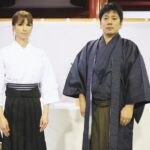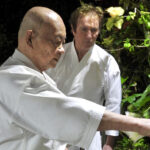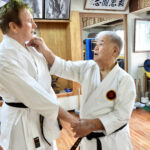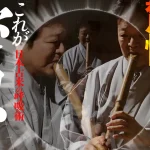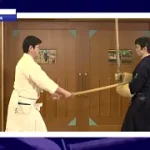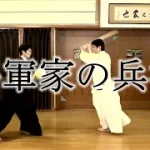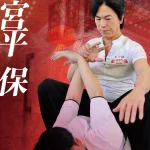text by Grigoris A.Miliaresis
The year was 1984. It was summer, I had just finished high school and was waiting for my college examination results, contemplating my future (I was certain I wanted to study journalism but wasn’t exactly sure where and how) when I read it at a martial arts magazine: In Japan, there was a new university specializing in budo; it was something of a Physical Education school but you got the chance to study real budo, major in them and then be licensed to teach them! As a real teacher! I really wanted to see this; and yes, there were a few weeks when I even actually considered the possibility of attending.
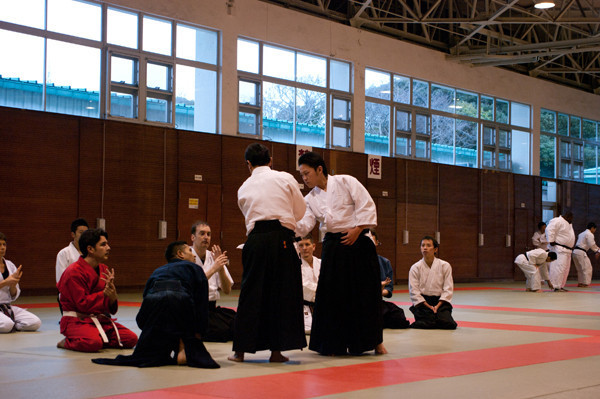
Life got in the way (I started working and all that) but I never completely forgot the International Budo University: I always thought it was a great idea, one that could only be realized in Japan and I was certain it would add to the country’s overall understanding of budo. And when many years later I heard about the International Budo Culture Seminar being organized by the Nippon Budokan and held at the IBU’s facilities, it seemed as the perfect event in the perfect place. Japan’s budo authority is introducing Japanese budo in the place more appropriate for such an event: Japan’s only college dedicated to these arts. This, I really needed to see.
But life kept getting in the way and it wasn’t until this year that I got the opportunity to see from up close what the International Budo Culture Seminar is all about. Thanks to “Hiden” and Mr. Yoshino, Nippon Budokan’s Assistant Director of Promotions, I had a first row seat for two full days of the four day seminar which every year draws 100 participants from all over Japan (actually, from all over the world) and teaches them some of the deepest aspects of budo –that is, things you don’t normally get to see or hear in your regular practice in the dojo.
Saturday, March 10 was a very cold morning up in Katsuura, Chiba Pref. The shopping area around the station was still empty and, as is often the case there were plenty of taxis waiting at the designated stop. I got into the first one and as soon as took my seat, the driver asked me “You are going to the Budo University, aren’t you? There have been a lot of foreigners coming in since yesterday –is there some special event up there these days?” I replied “Yes” and he continued “It’s a great idea having a Budo University. Japan could use more of those. Have you heard that from this year budo is becoming a compulsory subject in junior high schools?” I had, but in the next two days I would hear more on that subject since it was the seminar’s main theme.
Inside the IBU’s auditorium it was warm and surprisingly cozy –considering the size. Almost half of the seats were occupied while on the stage there was a big banner with the words “The 24th International Seminar of Budo Culture” and a table with two of Japan’s most prominent teachers of kendo and Shorinji kempo: Sakudo Masao, hanshi 8 dan, Professor in the Osaka University of Health and Sport Sciences, vice-chairman of the Osaka pref. Kendo Federation and member of the All Japan Kendo Federation Instruction Committee and Akiyoshi Yoshimi, seihanshi 8 dan, instructor and examiner in the Shorinji Kempo Headquarters. Even people who practice budo in Japan, don’t have many opportunities to hear teachers of such a caliber speak from the heart and say what budo means to them but this was exactly the subject of their lecture: “Budo to Me”

Maybe because of his energetic speech, delivered in English through Dr. Alex Bennet, (himself a prominent member of the kendo community as he is a renshi 7 dan and among the pillars of the Kendo World web site), Sakudo hanshi’s speech really grabbed the audience right from the start. Connecting the training of budo with the Japanese culture’s emphasis on the four seasons, he passed to the subject of kangeiko, the very intense winter training sessions that go on for 1-2 weeks and mark the start of the New Year. Sakudo hanshi is a strong believer in the value of kangeiko, mostly because it helps strengthen the spirit of community between old and new members of a dojo or club; for him, this community spirit is what kendo must re-discover and try to instill to the junior high school students.
Shorinji Kempo’s Akiyoshi Yoshimi was a much milder speaker than Sakudo hanshi; he also seemed like a milder person as well; this is not to say he lacked nerve but he had a much quieter attitude, which goes well with the Zen Buddhism aspects tightly woven into the art’s fabric. Akiyoshi seihanshi’s memoir, had to do with his personal trip down the budo/Shorinji Kempo road, a trip that started with the need of a weak child to become stronger (a story many budoka can relate to) and culminated in him becoming one of the art’s most prominent teachers. The challenges he had to face, and continues facing as a budo teacher and as an educator were the core of his lecture and it seems that his 50 years of training and teaching have started bearing fruit. “If we learn anything from budo, is how to foster better relationship –with our self and with the people around us” said the Shorinji Kempo teacher “and how to be a positive influence to society”. This, for him, is the main influence budo should have to Japan’s youth and this is why having budo in junior high schools is important.
Hearing a teacher of Sakudo hanshi’s status and experience say out loud that kendo might have become over-focused on the competition aspect and might have lost a part of its budo nature came as a surprise to many seminar attendees. “I’d never thought I’d hear that coming from a Japanese sensei” said an American kendoka during the 15-minute break, while another American, training in karate and jujutsu continued “I always thought these kendo guys never care for anything more than the next championship. It seems that there are people who really care about the ideals of budo after all!” Well, of course they are –but then again, how often does someone who trains in karate and jujutsu get to hear a kendo hanshi speak? This is probably one of the main benefits of the ISBC!
After the break, we returned to the auditorium for the next lecture, this one by Tsukuba University Professor Todo Yoshiaki, judo 7 dan, member of the All Japan Judo Federation Education and Dissemination Committee and author of five books on the theory and culture of judo. Professor Todo’s lecture was “The Educational Outlook of Jigoro Kano in Judo”, a matter of great interest since Jigoro Kano is the budo world’s most notable educator and many believe that the way judo has developed can function as a model that other arts can follow. The very interesting visual material Professor Todo had prepared added much to his lecture and helped create a more complete picture of the development of this unique art.
For Professor Todo, the epitome of Jigoro Kano’s philosophy is the two maxims (“Seiryoku Zenyo/Jita Kyoei” or “maximum efficiency/mutual benefit”) so his lecture illustrated Kano’s journey towards these principles. Starting from his introvert, intellectual character and his need to become stronger, passing through his education both in the Meiji academic environment and in the traditional jujutsu schools, his research for both a system that works and a method this system can be taught and finally, to the creation of Kodokan, the speaker painted a lively picture of the great budo innovator and explained how his work can help create better people and a better society.
The audience’s interest for Professor Todo’s lecture was mirrored in the many questions he received in the end. People asked him about the importance of kata in judo (Kano believed that if judo is a language, randori is the “words” but kata is the “grammar” that teaches people how to speak correctly), about the courses teaching judo to the people who will man the junior high school budo program from April 2012, about Kano influencing and being influenced by the principles of the International Olympic Committee and even if there was a dark side in Kano’s personality since we always get to hear only good things about him!
Although he answered pleasantly that probably Kano’s only character flaw was that as he was constantly trying to find financial support for his work and for his travel abroad, he was very often in debt, one of the most interesting answers was the one regarding how judo can return to Kano’s ideals. Professor Todo’s reply was that the only thing the judo teacher needs to do is sit down with his students after class and explain to them the ideas behind the art they just trained in; this way, they will understand that there are more aspects to their art than the physical/technical side they experience during training. “Judo is for life”, said Professor Todo. “Jigoro Kano believed that and I think that it is as true today as it was 100 years ago”.
The time was 12:00 and we had to return to the Nippon Budokan Training Center for the rest of the day’s program. The weather was still cold and rainy so we rushed into the IBU buses for the short ride to the facility (this is where the training takes place and this is where the attendees stay for the four days of the seminar). While the buses were going up and down the green hills of Katsuura, I had the chance to speak a little more with some of the participants; even though for most of them “budo” means “training in the dojo”, participating in this morning lectures was a pleasant surprise and a welcome diversion. As an English iaido practitioner put it, “It is the first time I come across people who view budo as an academic subject; people who can sit and discuss budo in such a way. In my dojo, we go, we train, we leave and we hardly ever discuss theory or history other than the basics about iaido’s origin and the development of the kata. It is a revelation to hear people who know these subjects good enough to write books about them; obviously I knew such people exist but we almost never have the chance to meet them”.
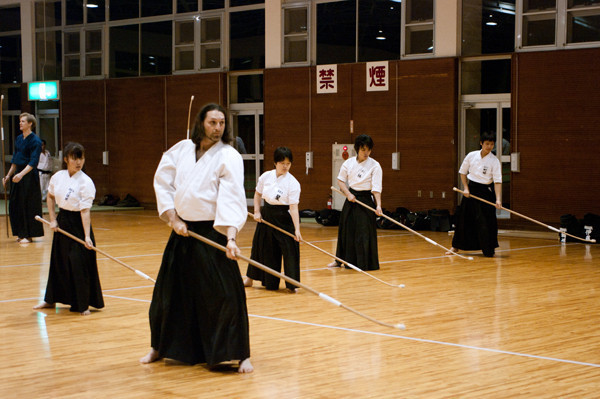
Related article:24th Budo Culture Seminar: Educational power of budo Part.2
 About the author
About the author
Grigoris Miliaresis has been practicing Japanese martial arts since 1986. He has dan grades in judo, aikido and iaido and has translated in Greek over 30 martial arts’ books including Jigoro Kano’s “Kodokan Judo”, Yagyu Munenori’s “The Life-Giving Sword”, Miyamoto Musashi’s “Book of Five Rings”, Takuan Shoho’s “The Unfettered Mind” and Donn Draeger’s “Martial Arts and Ways of Japan” trilogy. Since 2007 his practice has been exclusively in classic schools: Tenshin Buko-ryu Heiho under Ellis Amdur in Greece and Kent Sorensen in Japan and, since 2016, Ono-ha Itto-ryu under 17th headmaster Sasamori Takemi and 18th headmaster Yabuki Yuji.
http://about.me/grigorismiliaresis

